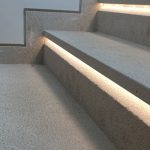Various Types of Building Materials: Concrete, Masonry, Wood and Steel

Various Types of Building Materials: Concrete, Masonry, Wood and Steel
A building material is any substance used to assemble a structure. There are various types of building materials ideal for projects of any scale in the construction industry. Some of these material used in construction includes brick, stone, plaster, mortar and concrete. They all interact with moisture in the air, with water adsorbing or diffusing through their pores. So, durability and strength of a building is an essential factor.
Three Little Pigs Story
We all know the story of the three little pigs. One builds a house with straw, another with sticks, and another takes the time to build his with bricks. The first two houses fall easily to the big bad wolf, but the brick house stands strong, showing the importance of hard work and of choosing the right building material for your structure.
While there’s no big bad wolf coming to blow your house or business down, it stands true that some building materials are better suited for your project than others. Today, most structures are composed of wood, steel, concrete, or masonry. Each material has its own strengths and weaknesses that should be considered.
In most cases, engineers and architects utilize a combination of these materials in their designs to balance cost, aesthetics, structural integrity, and longevity. We’ll go into detail about what those strengths and weaknesses are, so you can take an active role in evaluating your structure’s design.
Concrete
Concrete is the combination of cement, aggregates like sand or stone, and water. This mixture is poured into forms, which then dries and hardens, forming anything from walls to supporting beams to sidewalks.
Concrete is both durable and strong, making it a great option for your structure’s foundations. It can handle the weight of the above structure, and it can also stand up to the moist soil that surrounds it.
Concrete can also be used to construct entire structures. It is a low-maintenance finish, lasting for a long time and holding up to a variety of environmental threats. Additionally, concrete buildings are energy efficient, able to passively transfer heat absorbed during the day and release it at night while it’s cooler.
Concrete Downsides
That said, concrete requires a different skillset to install compared to wood or metal. You’ll want to be sure to work with a trusted and experienced concrete team to ensure your structure is built correctly and can stand the test of time. Compared to wood and metal, concrete may be more expensive to use for your structure. However, its benefits can make it an attractive option. Concrete’s durability and energy efficiency may cost building owners less in the long run to operate and maintain, making that larger upfront cost easier to swallow.
Masonry
Whereas concrete structures are set in place as one structure, masonry utilizes many smaller units mortared together to make one structure. Common masonry materials include clay bricks, concrete blocks, stone, and more. From the pyramids to Greek temples, masonry structures are amongst the oldest surviving buildings in the world. Able to bear the weight of several stories, masonry is a proven load-bearing material and can be reinforced with steel beams for additional support.
Masonry offers great protection against fire and can stand up to wet conditions and pests. Like concrete, masonry can be quite efficient for heating and cooling the building, as the bricks or blocks maintain a fair amount of heat in the winter and will stay cooler in the summer.
Masonry Downsides
However, masonry is not without its downsides. The bricks, stones, or blocks are relatively heavy, and they require a fair bit of time to properly install. Because of this, specialized craftsmen are often required to complete the project, and a good project plan is essential to keeping the project progressing.
Compared to wood, steel, and concrete, masonry tends to be on the more expensive side. Bricks require labor to turn raw materials into building materials that then need to be shipped and installed by craftsmen.

Wood
Humans have been using wood for thousands of years to build shelters and structures. Despite centuries of technological advances and the invention of many synthetic materials, wood is still a popular choice for building projects. Wood’s popularity comes from its relative affordability. It is also lightweight and can be easily worked with. It acts as an insulator, keeping warm air in and cold air out.
And while it may seem like cutting down trees to build a building is bad for the environment, wood can be an eco-conscious option if bought from a responsible timber supplier committed to sustainable forestry. Wood also has a lower carbon footprint than other materials, using less water and energy to produce.
Drawbacks of Wood
Wood does have a few drawbacks. It isn’t always ideal for supporting a lot of weight, meaning wood isn’t the best option for buildings with many stories. And unlike some synthetic materials, wood lasts only a few hundred years before it eventually decays. It’s also susceptible to fire and moisture damage and can fall prey to destructive termites.
Steel
Steel is a popular material for building because it is strong without being extremely heavy. This makes it the ideal material for large, multi-story buildings and manufacturing and industrial facilities. Unlike wood, steel can stand up to moisture and is not susceptible to termites and fire. It also will last much longer than wood. Steel can accommodate wide, open designs while maintaining the structural integrity of the building, in contrast to masonry. It’s also malleable, giving designers the freedom to explore more unconventional building shapes. As a manufactured material, steel materials are consistent and predictable, making repeatable, exact, precise craftsmanship easier to achieve.
Steel Drawbacks
Using steel to frame a building will be more expensive than wood. A good structural engineer will be able to economize, using enough steel to safely construct your building and sustain the above load while monitoring and limiting unnecessary expenses. So, while steel is an attractive alternative to wood for its increased durability and longevity, it will be more costly.
What Building Materials Are Best for You
All building materials have their pros and cons. Understanding these benefits and shortcomings will allow you to weigh them against the goals you have for your project. That way, you can determine which is the best material or combination of materials for your project. Because what you chose to build your structure out of is a big decision, it’s highly suggested to consult with an experienced design team.
To learn more about us, click here.
Send your price quotes directly to our WhatsApp through this Link: https://wa.link/ord5k8
Sources
www.horstconstruction.com/news-and-blog/whats-the-best-building-material/
hidenisochema.com/materials/building-materials/
masterclass.com/articles/building-materials-guide
www.igus.eu/info/energy-chains-building-material
Article
Natural Stone Applications
- 22 December 2022
Iranian Stones Introduction According to Source and Quarry
- 21 December 2022
Technical Stone Introduction and Quarrying Procedures
- 21 December 2022
Categories
- blog757
- news1
- Specialized articles756













